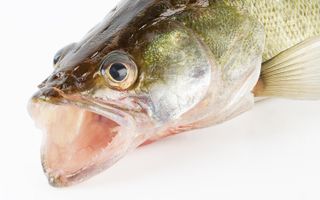Rumble Fish on Behalf of Arts and Crafts Galleries
Rotting Fish Art Explodes, Causes Burn down in London Gallery

Something was rotten in a London art gallery last week — an installation of sequin-embroidered decomposing fish sealed in clear plastic bags.
Just before the showroom even opened, the malodorous artwork unexpectedly combusted and set up fire to the gallery.
The installation — a slice called "Majestic Splendor" past Lee Bul — was office of an exhibition of the Korean artist'southward work, scheduled to open up at the Hayward Gallery on May 30. So, hours before the show's first preview, the gassy art blew upwards, causing a fire that damaged office of the gallery, artnet News reported. [Top x Greatest Explosions Always]
Even though the exhibit was non yet open to the public, gallery officials had already decided to remove "Regal Splendor" from the bear witness for prophylactic reasons. They had learned before that a chemical added to the fishes' bags to dampen their smell could become combustible afterward combining with gases released by the decomposing flesh, and fine art handlers were taking down the art as a precaution when information technology suddenly combusted and sparked a burn down, a gallery spokesperson told frieze mag.
"Royal Splendor" previously raised eyebrows — and wrinkled noses — when information technology was presented at The Museum of Modern Art (MoMA) in New York Metropolis in January 1997. Dozens of small, transparent numberless were stock-still to a wall; each contained a rotting fish decorated with stitched-on sequins and beads, representing Bul's scathing commentary on the fleeting nature of dazzler for highly ornamented women, according to the 1997 MoMA exhibition catalog.
Merely after a custom-designed refrigeration unit for the MoMA installation failed, the aroma was so awful that museum officials nixed the display and removed information technology, and subsequent showings included an odour-reducing chemical known as potassium permanganate, the Guardian reported.

Scents and sensibility
As fish decay, they emit amines — compounds of carbon, hydrogen and nitrogen — which produce odors that are intensely powerful and distinctively "fishy," Preston MacDougall, a professor with the Department of Chemistry at Centre Tennessee State University, told Alive Science in an electronic mail.
But these compounds aren't just smelly — they're also potentially explosive. Sure molecular bonds connecting hydrogen and carbon can release a lot of energy when vaporized — in gasoline, high-free energy bonds in hydrocarbon molecules give the fuel its kicking (and make it highly flammable). Similar energy reserves lurk in the molecular bonds of hydrogen and carbon compounds produced by decomposing fish, creating the possibility of an explosion under the right weather, MacDougall explained.
For the new show and for previous installations later the MoMA debacle, potassium permanganate — likewise known equally KMnO4 — was added to "Majestic Splendor" to reduce the aroma of the rotting fish. In fact, KMnO4 is a time-honored choice for masking strong odors, Raychelle Burks, an assistant professor of chemistry at St. Edward's University in Austin, Texas, told Live Science in an email.
"This chemical is a good oxidizing agent, reacting with a range of stinky, volatile organic compounds (VOCs) to produce far less stinky or no-stink compounds," Burks said.
Only when combined with flammable material, KMnO4 is known to trigger violent explosions nether sure circumstances, she added. It'southward possible that the compounds produced by the putrefying fish interacted with KMnO4 to spark combustion, simply it's as well likely that the explosion was caused by pressure buildup from trapped gases that had nowhere to go, like to the effect that causes beached and bloated expressionless whales to explode, Burks told Live Science.
Afterwards the gallery incident, firefighters quickly put out the blaze, and a security guard was treated for fume inhalation; impairment to the Hayward Gallery from the fire was "superficial" and contained in ane small department of the exhibit space, co-ordinate to artnet News. The exhibit, titled "Crashing," opens today (June i) and will run through Aug. 19 — minus the malodorous and volatile fish brandish.
Original article on Live Science.
Source: https://www.livescience.com/62732-rotting-fish-explosion-art-gallery.html

0 Response to "Rumble Fish on Behalf of Arts and Crafts Galleries"
إرسال تعليق